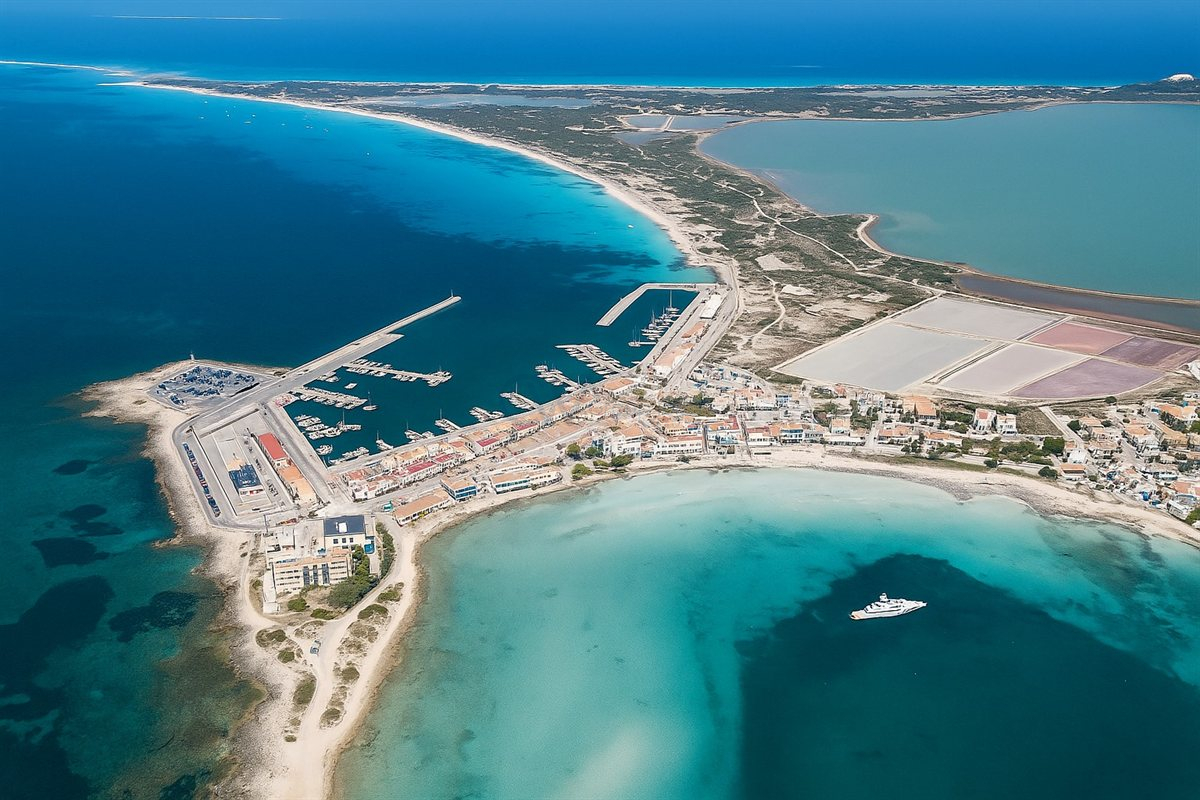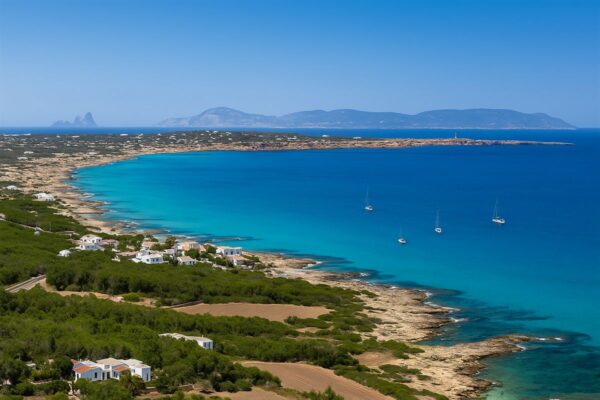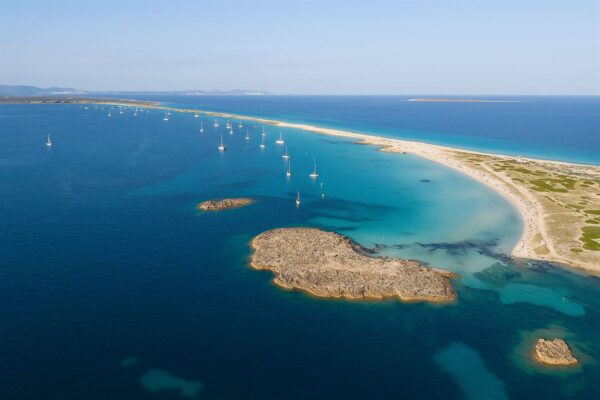Come to the Balearic Islands and Live in Formentera
This little Mediterranean island is one of the true jewels of Spain, a tiny corner of the world where white sands meet turquoise waters, and life moves at a slower, more graceful pace. No airports, no crowds, just a handful of quiet roads connecting small villages and secret beaches. That’s the beauty of Formentera: simplicity, peace, and the feeling that you’ve found somewhere untouched by time.
At just 82 square kilometres, Formentera is the smallest and most southerly of the Balearic Islands. Together with Ibiza, it forms part of the Pityusic Islands. The island stretches for about 20 kilometres, narrowing to only two at its thinnest point. Mostly flat, it rises at its highest peak, La Mola, 193 metres above sea level, where dramatic cliffs drop into the endless blue. View Formentera on Google Maps

For centuries, salt was the lifeblood of the island. The old salt flats shimmered pink in the sun and were the main source of income until 1985, when production finally ceased. Today, Formentera lives off tourism, but you can still see flocks of sheep resting under fig trees, whose branches are supported by wooden beams in the traditional style.
The island can only be reached by ferry from Ibiza Town, which takes about 30 minutes by high-speed ferry. This simple fact is what makes Formentera so exclusive, a hidden gem just a short boat ride away.
Life and people on Formentera
Only about 12,000 people live on Formentera year round, but in summer this number grows with sun-seekers from all over the world.
Yet even in the height of summer in August, the island never feels as chaotic as its sister islands.
There are no large resorts, only small hotels, fincas, and beach houses tucked away among the pine trees. The pace here is slow, mornings begin with the sound of the waves, afternoons are spent enjoying long lunches, and sunsets feel like little ceremonies. Formentera is a place where you can switch off, take a deep breath, and rediscover the simple joy of doing nothing.
Beaches and real life on Formentera
The beaches are what make this island famous. They’re the reason travellers fall in love with Formentera and return year after year.
Ses Illetes, on the northern tip, is the island’s icon, a strip of powder white sand surrounded by shallow turquoise water on both sides. Often listed among the most beautiful beaches in the world, it’s as close as you’ll come to the Caribbean in Europe. Just to the east lies Platja Llevant, where rolling dunes and gentle waves attract those seeking peace and natural freedom. Further south, the long, wild stretch of Migjorn Beach offers kilometres of soft sand and rocky coves, perfect for walking barefoot, stopping for lunch, or watching the sun melt into the sea. If you prefer intimacy, Cala Saona enchants with its calm, crystalline waters framed by red cliffs, while Caló des Morts feels like a secret, a small rocky cove where time disappears. Whichever spot you choose, the sand is fine, the water impossibly clear, and the atmosphere pure serenity.
Experience and enjoy the sea in Formentera
The magic of Formentera lies in its crystal clear waters. Beneath the waves, the island hides one of the most species-rich underwater worlds in the Mediterranean. The seabed here is protected by extensive meadows of Posidonia oceanica, a seagrass that is so important that it is a UNESCO World Heritage Site. This living forest keeps the water clear and is home to an incredible variety of marine life.
If you dive, Formentera offers unforgettable dive sites, from La Mariana and El Arco to the Punta Rasa caves. Most impressive is the Don Pedro shipwreck, the largest in the Mediterranean, which lies at the bottom of the sea near Ibiza with a length of 140 meters. Today it is home to barracudas, moray eels, and colorful groupers.
The Lighthouses of Formentera
At the island’s southern tip stands the Cap de Barbaria Lighthouse, surrounded by a lunar like landscape of flat rock and wind shaped bushes. The walk to the end feels like a journey to another world, and the sunset here, fiery orange fading to violet, is pure magic. Nearby, through a small hole in the ground, you’ll find Sa Cova Foradada, a hidden cave opening onto a natural balcony above the sea.
To the east, on the cliffs of La Mola, the island’s highest point, rises another icon: Far de la Mola. Jules Verne once described this spot as “the end of the world.” Standing here, with nothing but sky and sea stretching before you, you’ll understand why. And back near the port, the small La Savina Lighthouse welcomes every visitor, the first and last glimpse of Formentera before the open sea.
Whitewashed Villages – The Soul of Formentera
Formentera’s villages embody its quiet elegance: simple, whitewashed, and timeless. The island’s capital, Sant Francesc Xavier, is its beating heart. With just 3,000 residents, it still feels like a village where everyone knows each other. Around the main square stand charming boutiques, artisan markets, and open-air cafés shaded by bougainvillea. Don’t miss the local church, both fortress and sanctuary, and the daily rhythm of locals chatting over coffee.
La Savina, the gateway port, comes alive in summer with sleek yachts and relaxed marina restaurants, perfect for people-watching at sunset. Nearby, Es Pujols blends beach life with easygoing nightlife: strolls along the promenade, aperitifs by the sea, and late dinners beneath lanterns. Further east, Es Caló de Sant Agustí preserves the island’s fishing heritage with its wooden boathouses and simple seaside taverns. And up in El Pilar de la Mola, at the island’s highest point, a weekly artisan market fills the streets with local crafts, handmade jewellery, and music.
Each village tells a different story, all connected by the same gentle rhythm.
Good Restaurants of Formentera
For a special meal by the water, the island has plenty of iconic spots:
El Tiburón and Gecko Beach Club on Migjorn Beach, perfect for relaxed lunches with your feet in the sand.

The quiet beauty of Formentera and nature
Away from the beaches, Formentera reveals a different, quieter side. Between dunes, lagoons, and salt flats, the island protects some of the most valuable natural areas in the Mediterranean.
The Ses Salines Natural Park covers more than 14,000 hectares between Ibiza and Formentera, a mosaic of shallow lakes, ancient salt pans, and quiet paths where you can often spot flamingos, herons, or seabirds. The light here is soft and golden, especially in the late afternoon when the sun is over the salt flats.
On the southeast coast lies the Reserva Marina de la Punta de Sa Creu, a marine reserve with crystal clear waters that is home to dolphins and sea turtles. Snorkeling is allowed here and well worth it: just a few meters below the surface, you can see sea grass beds, colorful fish, and the sparkling blue that makes Formentera so special. If you want to dive, you need a permit – to protect this fragile paradise.
These places show why Formentera is more than just sun and beaches: it is a piece of unspoiled Mediterranean, quiet and lively at the same time.
The most beautiful seasons in Formentera
Every season changes the face of the island. In summer, especially in July and August, it is bustling with life. Ferries bring visitors from Ibiza, the beaches are lively, and the sea glistens in the sunlight. Those seeking peace and quiet are better off traveling in spring or fall: from April to June and in September or October, the light is softer, the sea is warm enough for swimming, and the island feels peaceful and relaxed.
In winter, Formentera shows a completely different side. With mild temperatures around 16°C and little rain, it is ideal for hiking, cycling, or horseback riding. Many restaurants close during this time, but in places like Sant Francesc or Es Pujols, life remains quiet and authentic, an island only for those who really want to arrive.
As Formentera has no airport, it can only be reached by sea, and that is precisely what makes it so appealing. Ferries from Ibiza to La Savina run regularly and take 30 to 60 minutes, depending on the connection. Everything feels close on the island itself: by bike, e scooter, or small car, you can reach almost any place in 20 minutes. Paths crisscross through pine forests, salt fields, and small bays everywherer, perfect for just setting off and letting the day drift by.
If you really want to arrive, you should stay at least four to five days. Only then can you feel the rhythm of the island , the slow pace, the salty wind, the light that bathes everything in pastel colors.
The Spirit of Formentera
Formentera is more than a destination, it’s a feeling.
In the morning, the air smells of salt and sun; at midday, the sea is calm and clear; and in the evening, the sky sparkles like an endless canopy of stars.
Here, you forget the time, the noise, the pressure. Everything becomes simpler, more natural, more real. Formentera reminds us that sometimes happiness only needs a ray of sunshine, a glass of wine, and the sound of the waves.
Come to the Balearic Islands – and live in Formentera.

Written by: Christian Wolf, CEO
The efficiency of a real estate agent when selling or buying a property in Ibiza -
The CW Group Ibiza is at your disposal with its many years of experience.



